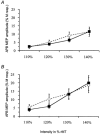Modulation of human corticomotor excitability by somatosensory input
- PMID: 11956348
- PMCID: PMC2290238
- DOI: 10.1113/jphysiol.2001.012801
Modulation of human corticomotor excitability by somatosensory input
Abstract
In humans, somatosensory stimulation results in increased corticomotoneuronal excitability to the stimulated body parts. The purpose of this study was to investigate the underlying mechanisms. We recorded motor evoked potentials (MEPs) to transcranial magnetic stimulation (TMS) from abductor pollicis brevis (APB), first dorsal interosseous (FDI), and abductor digiti minimi (ADM) muscles. MEP amplitudes, recruitment curves (RC), intracortical inhibition (ICI), intracortical facilitation (ICF), resting (rMT) and active motor thresholds (aMT) were recorded before and after a 2-h period of ulnar nerve electrical stimulation at the wrist. Somatosensory input was monitored by recording somatosensory evoked potentials. To differentiate excitability changes at cortical vs. subcortical sites, we recorded supramaximal peripheral M-responses and MEPs to brainstem electrical stimulation (BES). In order to investigate the involvement of GABAergic mechanisms, we studied the influence of lorazepam (LZ) (a GABA(A) receptor agonist) relative to that of dextromethorphan (DM) (an NMDA receptor antagonist) and placebo in a double-blind design. We found that somatosensory stimulation increased MEP amplitudes to TMS only in the ADM, confirming a previous report. This effect was blocked by LZ but not by either DM or placebo and lasted between 8 and 20 min in the absence of (i) changes in MEPs elicited by BES, (ii) amplitudes of early somatosensory-evoked potentials or (iii) M-responses. We conclude that somatosensory stimulation elicited a focal increase in corticomotoneuronal excitability that outlasts the stimulation period and probably occurs at cortical sites. The antagonistic effect of LZ supports the hypothesis of GABAergic involvement as an operating mechanism.
Figures







References
-
- Allison T, McCarthy G, Wood CC, Jones SJ. Potentials evoked in human and monkey cerebral cortex by stimulation of the median nerve. A review of scalp and intracranial recordings. Brain. 1991;114:2465–2503. - PubMed
-
- Apland JP, Braitman DJ. Effects of non-opioid antitussives on epileptiform activity and NMDA responses in hippocampal and olfactory cortex slices. Brain Research. 1990;529:277–285. - PubMed
-
- Asanuma H, Larsen K, Yumiya H. Peripheral input pathways to the monkey motor cortex. Experimental Brain Research. 1980;38:349–355. - PubMed
-
- Aschersleben G, Gehrke J, Prinz W. Tapping with peripheral nerve block. a role for tactile feedback in the timing of movements. Experimental Brain Research. 2001;136:331–339. - PubMed
-
- Bastian HC. The ‘muscular sense’; its nature and cortical localisation. Brain. 1887;10:1–137.
Publication types
MeSH terms
Substances
LinkOut - more resources
Full Text Sources
Medical

